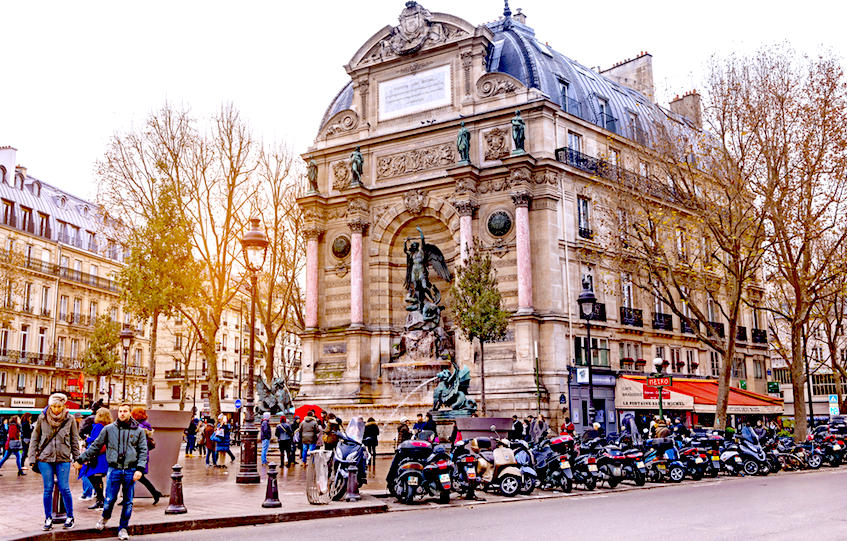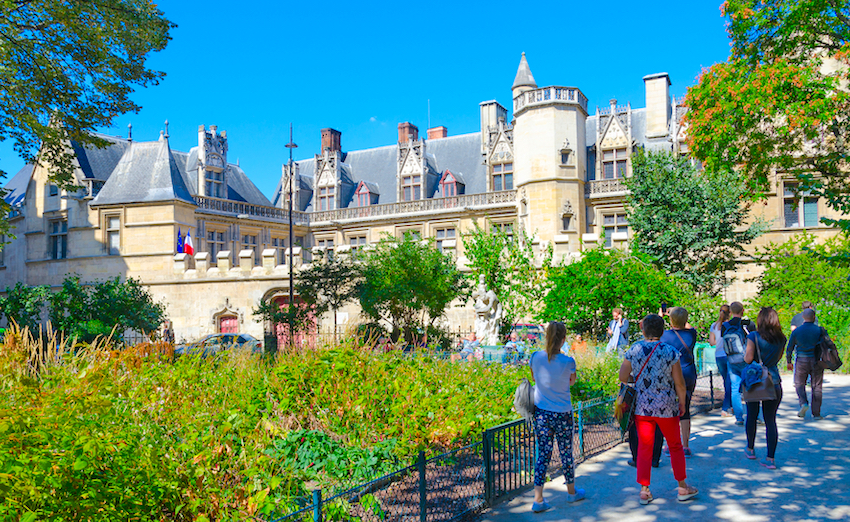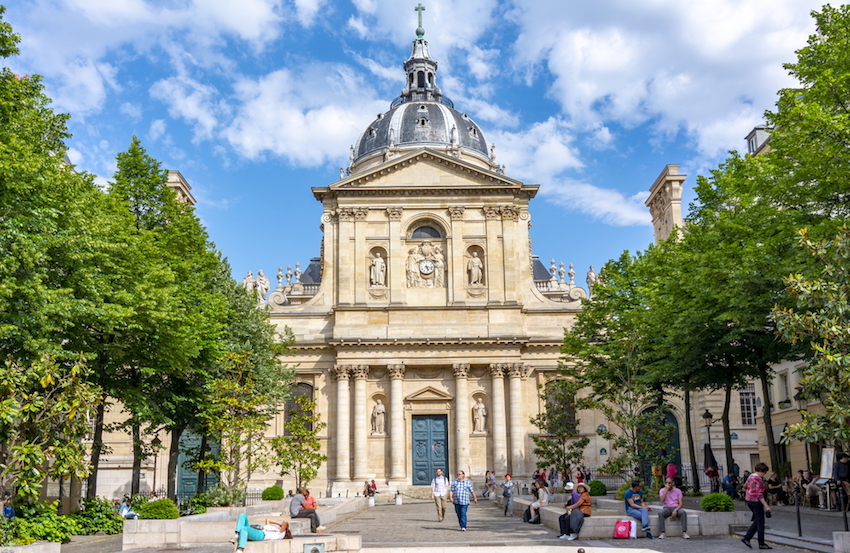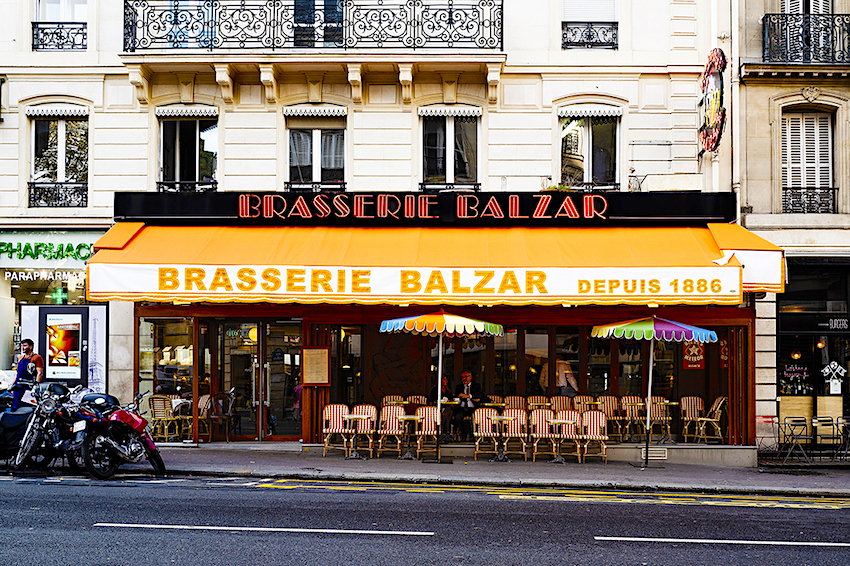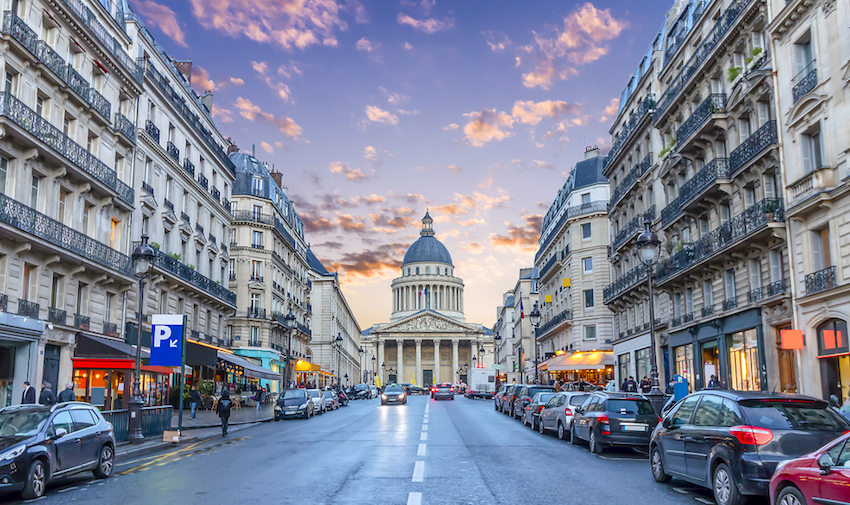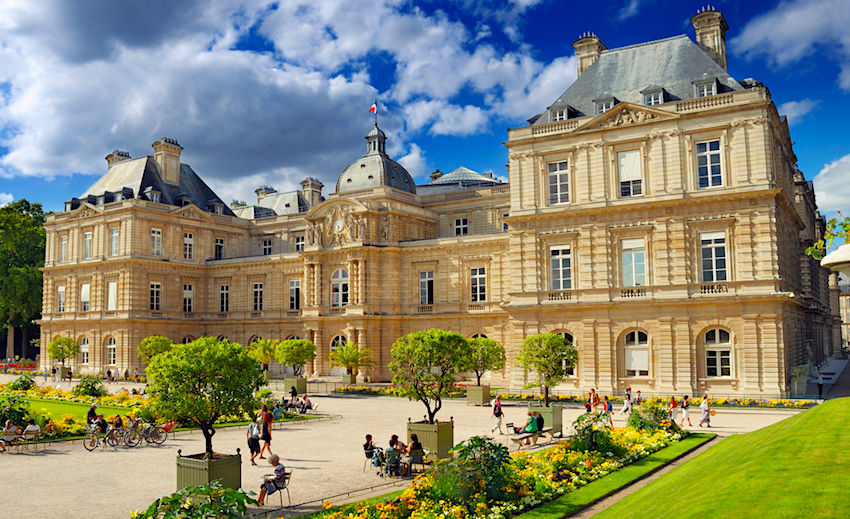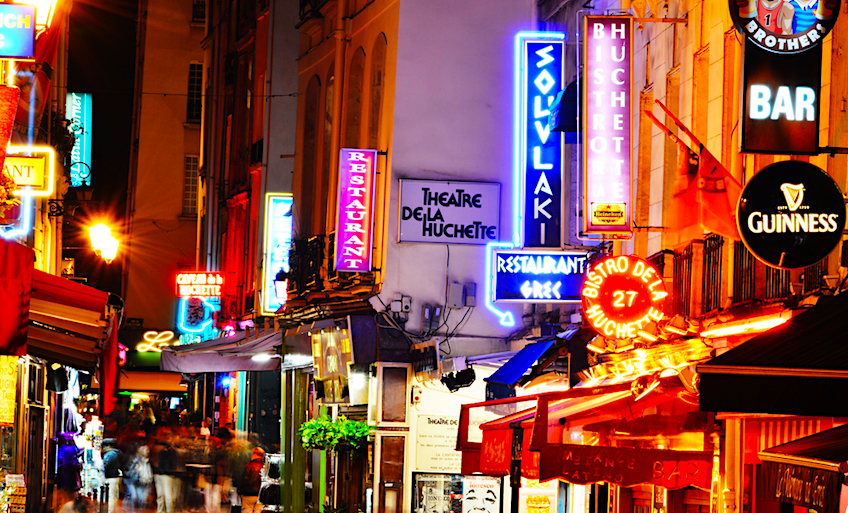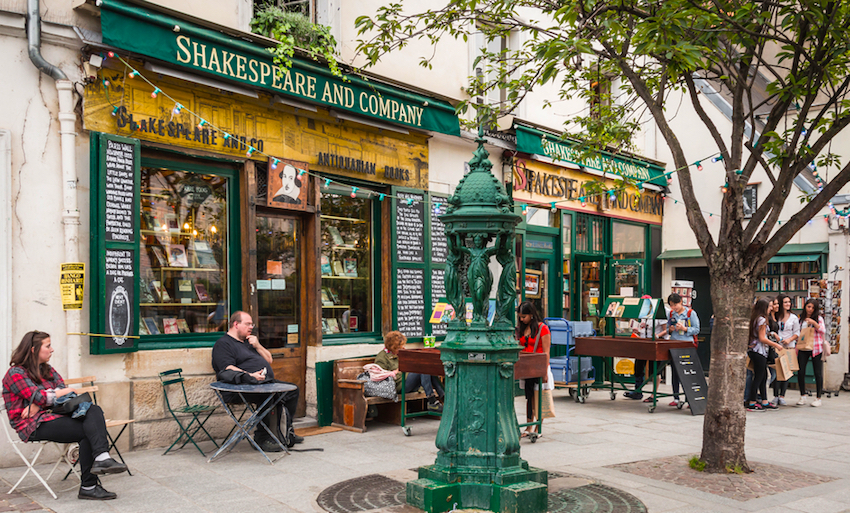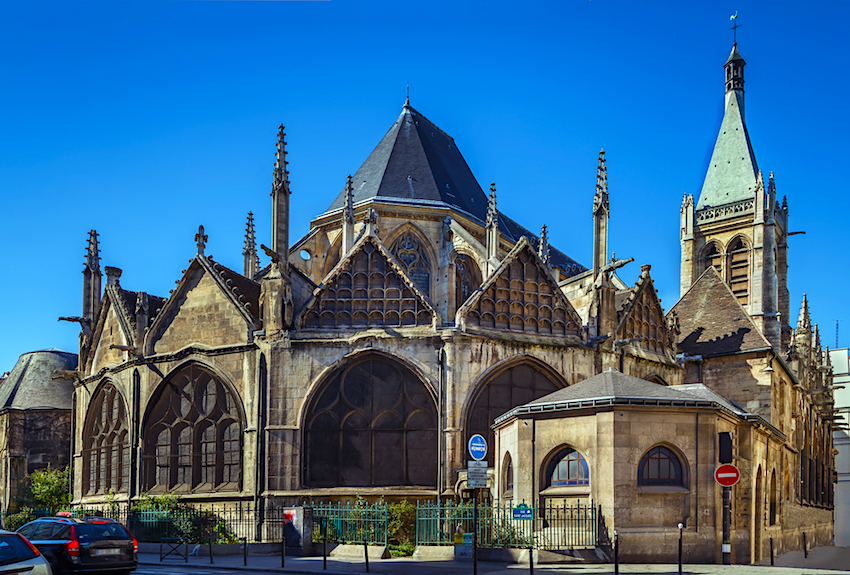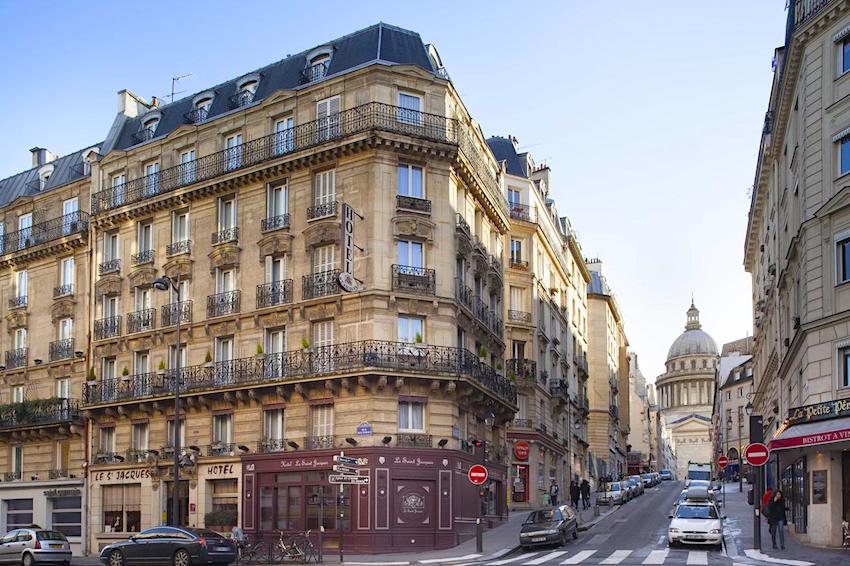A Paris Guide
Latin Quarter - St. Michel
Latin Quarter - St. Michel
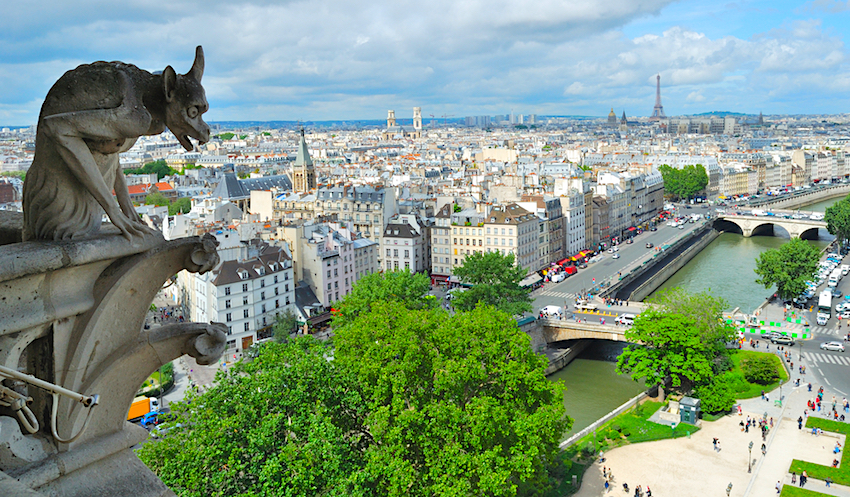
Quartier Latin--- the name alone evokes images of bohemian Paris at its height. In spite of its indisputable gentrification and the loss of its former identity, the myriad streets surrounding what was the left bank's true student and intellectual center continues to attract tourists and Parisians who hope to discover, or possibly resurrect, a little of that electric sense of change we read of in Camus, Sartre and Beckett. |
|
The heart of St. Michel is still the Place St. Michel (Metro St. Michel) with its baroque fountain of St. Michel killing a demon of some sort. This was once the site of numerous protests and social uprisings. One of the main events of French resistance to the occupying Nazis took place in the square, and in the now legendary riots of 1968, students took charge of the square in the face of tear gas and police clubs, declaring it an independent state! Odd as this may sound, it led workers to rally the same cause by announcing mass strikes, which led to the eventual fall of De Gaulle's government. This was once the "Washington Square Park" of Paris, filled with hippies, artists, writers, poets, dancers, musicians and art students. Now you are more likely to see the "Des Moines Bingo Club" on tour, en masse, zipped up in North Face and Gore-Tex as they climb the harrowing length of St. Michel in the extreme conditions of an late spring chill. |
|
The Latin Quarter is bisected by the Boulevard St. Germain and the Boulevard St. Michel. These are the two main arteries running through the area, with the hundreds of crooked streets leading off them like capillaries. The tree lined Place St. André des Arts, which was a gathering place for many French artists, is still ringed with bistros and restaurants. Walk up St. Michel until you reach the intersection of Blv. St. Germain. The two streets intersect near the Cluny Museum on Boulevard St. Michel, a museum well worth visiting. It is set inside the ancient Roman baths (an astounding feat of architecture in itself) and filled with incredible artifacts and artwork from Medieval Europe, I find it to be one of the most interesting and beautiful museums in Paris. Inside you will find the famous "Lady and the Unicorn" tapestries as well as the original heads knocked from the statues at the Notre Dame Cathedral, stained glass, jewelry, early paintings, stonework, and even a Medieval garden. (Entrance is at 6, Place Paul-Painlevé, Metro Cluny-La Sorbonne, cost : 7 Euros, closed Tuesday) |
|
The walk up St. Michel is interesting in it's own right. I prefer the cafes on the higher end of the street after you pass the Cluny, which are generally less crowded and more authentic as far as bistros go. There are good used bookstores and art book stalls to browse through here. This is no coincidence--- the Sorbonne is just a few blocks away and the students are always on the lookout for cheap deals on their required reading. Take a little detour and inspect the legendary university, or stop at the nice little Place de la Sorbonne square on your left, and enjoy a coffee among chain-smoking, tragic-faced students. |
|
Across Blvd St Michel is the Rue Monsieur Le Prince that will lead you to Blvd St Germain at the Odeon Metro station and along the way you will pass several student oriented bistros and a couple Japanese restaurants as well as the Polidor at 41 Rue Monsieur le Prince, one of the oldest bistros in Paris, established in 1845. For a treat, though not an overpriced one, go to Brasserie Balzar at 49 rue des Ecoles near the Sorbonne which has been open since 1886, but make sure you have a reservation if you are going on Friday or Saturday night. |
|
For those still on Blvd St Michel just keep walking and turn left off the rue Soufflot and you will eventually run into the Pantheon. If you don't see it, you need major eye surgery--- this thing looks like it was designed to resist a nuclear attack, but with the inevitable Greek columns and Roman vault. Pantheon is a Greek word, meaning "all the Gods", which in this case means, the Gods of French literature, arts and sciences. All the big shots are buried here, in what is essentially a massive mausoleum. It was originally built as a church for which the foundations were laid in 1758. After the revolution, the new government decided it was more politically correct to rename it a mausoleum for the interment of French genius. Unable to make up their minds (all this philosophy has confused them) the French have twice reverted this building to being a church, and twice revoked its status. (imagine being the priest here--- no job security) Among those buried in its crypt are Voltaire, Rousseau, Honoré Mirabeau, Marat, Victor Hugo, Émile Zola, Jean Moulin, Marie Curie, René Descartes, Louis Braille and Soufflot the architect. (what a coincidence) It's in this same building that the famous physicist, Foucault, proved the rotation of the earth by hanging his 67 meter pendulum from the dome in 1851. If you look up toward the main pediment as you enter the building, the incription reads : Aux grandes hommes la patrie reconnaissante (For great men, the grateful nation) No, there is no application process… |
|
By the way you are now very close to the Luxembourg Gardens so plan to go in and walk around and enjoy one of the most beautiful green areas of Paris with the many people who come here when the weather is nice. The Palais du Luxumbourg built in the 17th century for Marie de Médicis, mother of King Louis XIII of France dominates the north end of the park along with a large pool where children sail boats and Parisians read the paper or soak up sun. |
|
If you head back down toward the river, you can loop around the back of the Cluny Museum and investigate the small streets which have now been inundated by Tunisian kebab shops and wannabee Greek restaurants. No self respecting Greek with a good restaurant will stand on the street and break plates for you. This is what you will find in the ultra-touristy rue de la Huchette. These guys mostly pose as Greeks by yelling OPA! and crunching broken plates on the sidewalk under their shiny shoes. I love a good North African specialty, so why these places are determined to make you think you are in Athens, when you are clearly not, is beyond me but maybe you were on your way to Athens and just kinda got stuck here and this will have to do. How good the food is I could not tell you having done little more than chat with the doormen but they create very appetizing window displays that may entice you to enter. There are a few bars, some with live music, romantic singer-songwriters on piano or guitar, male or female. If you are on a budget you will find plenty of fast food joint, souvlaki shops, sushi, bakeries, Indian and 'authentic French cooking', written in big letters in English so it must be true. |
|
Keep walking down the alley, cross the street and you will eventually run into the Shakespeare and Company Bookstore
at #37 rue de la Bucherie. This is truly a sight not to miss. Of all the English language bookstores in Paris,
this one has the most interesting feel. The shop is a remake of the original bookstore which was damaged by fire.
Founded by Sylvia Beach in the 20's, this became a focal point for expatriate Americans such as Pound, Hemmingway
and the Irishman James Joyce. It was actually Sylvia Beach who finally agreed to publish Joyce's much-rejected
novel, Ulysses. (a good move) The shop was later taken over by George Whitman who was an iconic figure in the
American ex-pat community. The shop is run by his stunning daughter. The bookstore
continues to offer refuge to young writers and poets who are allowed to sleep in the shop in exchange for some
hours work. If this seems strange, I think it should be commended as a remarkable act of generosity and empathy
in an age when things like this no longer happen. The architecture of the shop is interesting--- a maze of leaning
shelves, secret cubbyholes, piles of books, old sofas, posters and the occasional cat. This is a place to be preserved
and admired along with those who keep it running. If you are going to buy a book, why not buy it here and help
support this little enclave of culture. The benches and fountain outside the shop are also a wonderful place to
sit and watch the Notre Dame across the river. |
|
If you are interested in a fine example of the "flamboyant gothic style" check out the nearby church
of St. Séverin on the rue St. Séverin. Notice the medieval sewer system still visible in the street's
stonework. This church was named after a 6th century recluse and apparently took longer to build than the nearby
Notre Dame. There is a 15th century ossuary (bone garden) inside as well as an exceptional stained glass window
depicting the seven sacraments. It's little known that there are some beautiful 1920's etchings by the great painter
Roualt inside this church. Roualt was trained as a stained glass artisan--- hence the obvious reference in his
later famous paintings with their distinct color patches. Stephanos Papadopoulos |
Hotels in the Latin Quarter |
|
For hotels in the area check out Le Petit Belloy in the heart of the Latin Quarter, Boulevard Saint Germain and Notre Dame Cathedral. The Villa des Princes at 19 rue Monsieur le Prince is close to Luxumbourg Gardens just a few metres from the Boulevard Saint Germain. Hôtel des 3 Collèges is ideally located in a quiet street in the heart of the famous Latin Quarter, and offers free on-site parking, comfortable accommodation and Wi-Fi internet access. All three of these hotels are 2-star and economical. The 3-star Best Western Trianon Rive Gauche Hotel offers comfortable and tastefully decorated rooms close to the Jardin du Luxembourg and Blvd St Michel as is the nearby 3-star Hotel Fontaines du Luxembourg. For those seeking to spend a little more the Résidence & Spa Le Prince Régent is an 18th century building restored into an apartment hotel between Boulevard Saint Michel and Boulevard Saint Germain. Inspired by Alice in Wonderland, Hotel le Lapin Blanc is opposite the Middle Ages National Museum. This boutique hotel has a 24-hour reception and the chic guest rooms include satellite TV and free WiFi access. Hotel Saint Jacques offers comfortable en suite accommodation in the heart of Paris’ Latin Quarter near Ile de la Cite and Notre Dame Cathedral. Each Hotel Saint Jacques room is soundproofed and equipped with a private bathroom and satellite TV. The Europe Saint Severin-Paris Notre Dame Hotel is located just 1,150 feet from the Notre Dame Cathedral. It offers guest rooms with satellite TV, private bathroom and air conditioning. (Matt stayed here and liked it). There are also loads of apartments in the area which you can find buy using the maps and search options in the Paris Hotel Search |
Help Support Matt's Paris Guide
Do you enjoy using my site? Have you found it entertaining as well as useful? If so please show your appreciation by booking hotels through the links found on my Hotels Page. The small commission I make on the bookings enable me to keep working and in most cases you won't find them any cheaper by searching elsewhere. You can
also book at Booking.com's Paris Page and they give me a small percentage on each booking. If you are appreciative of all the free information you
get on my websites you can send a donation through Paypal.

